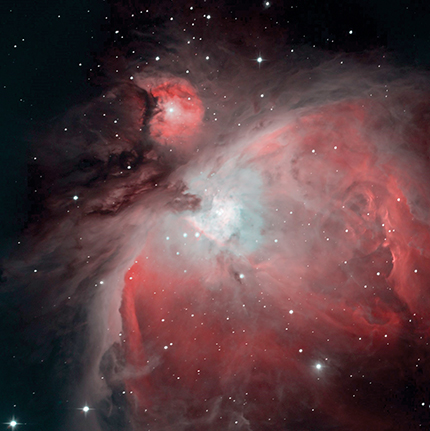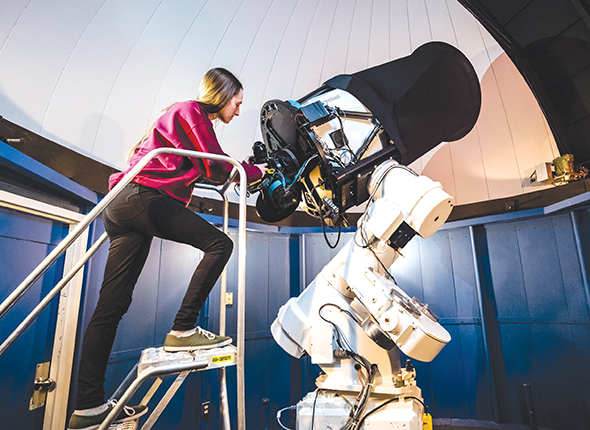Social media opens telescope operations to the world
DOI: 10.1063/PT.3.3264
Pick a celestial object that is visible from Nova Scotia. Not a bright star—it could saturate the camera. Not a constellation—they are too big. Got it? Ready, set, tweet!
On 29 February the Burke-Gaffney Observatory (BGO) at Saint Mary’s University in Halifax officially opened to the remote public. In the first few months, several hundred people from across Canada, the US, and Europe signed up to use the observatory’s 24-inch telescope. At any given time, 50 to 75 requests for astronomical images are in the queue, and observatory director David Lane hopes to eventually acquire 50 images per clear night.
As far as Lane is aware, the BGO telescope is the first that can be controlled automatically via social media; its Twitter handle is @smubgobs
The idea to use Twitter came with the BGO’s 2014 renovation, says Lane. Ralph Medjuck, a local commercial real estate developer who had anonymously given money for the original observatory in 1971, this time donated Can$150 000 ($115 000) and “we promised to deliver the social media interface,” Lane says. The university pitched in Can$30 000. The upgrade included a new telescope, cameras, weather sensors, automating components for the dome, and a rooftop observation deck.
On the software side, Lane spent about a year improving code he’d written to automate his personal 14-inch telescope and to interface it to social media. “For yourself you can afford to be sloppy,” he says, but for the BGO, “I had to make things more robust.”
When a user tweets or emails an observation request, the software checks whether the request is reasonable: Can the telescope interpret the request? Will the requested object be in the accessible sky within the next month? Are other observing criteria met?
For example, to the test commands “#request object=M78” and “#request object=M79” the observatory replied, “Sorry, I cannot observe M78 in the next 30 days!” and “Sorry, M79 never rises high enough to be observed at the BGO!” A successful command elicits a message saying the desired object “is in my request queue.” M78 (a reflection nebula) and M79 (a globular cluster) are objects listed in the Messier catalog, one of the sky catalogs in the BGO repertoire. Observers can also specify celestial coordinates, objects they add to the database via Twitter, and observable comets and asteroids, which are manually updated for the BGO every month or so.
New dimensions
The observatory goes into action automatically when it determines that the night sky is clear. It takes, calibrates, and processes

This image of the Orion Nebula was created from exposures collected robotically by the Burke-Gaffney Observatory. Martin Hellmich, a student majoring in astrophysics at Saint Mary’s University in Halifax, Nova Scotia, tweeted requests specifying filters and exposure times to form this composite.
MARTIN HELLMICH AND THE BURKE-GAFFNEY OBSERVATORY

David Chapman, a retired acoustical physicist, submits several requests to the BGO every week. Among the images he’s obtained are one showing the streak of a comet’s path from a five-minute exposure. He has “been trying to capture double stars, separate them, and see if I can see different colors.”
Controlling the telescope with Twitter “has been super useful in class projects,” says Tiffany Fields, an astrophysics major at Saint Mary’s who also works as a BGO operator. She used the telescope to chart changes in an active galaxy’s brightness every clear night over two months. In previous years, students would stay overnight to see if skies would clear, she says. “The weather here is temperamental. Remote requests made the process much simpler.” Fields notes that the BGO can be used to create pretty pictures or to gather quantitative data. And users can tailor their requests for color filters, exposure time, sky area, and other features. Saint Mary’s students have priority access to telescope time.
Says Chapman, “Telling the telescope to take images doesn’t replace going out and

Astrophysics major Tiffany Fields prepares to look through the Burke-Gaffney Observatory’s 24-inch telescope.
SAINT MARY’S UNIVERSITY

The next telescope operable via social media could be the Deep Sky Eye Observatory, a new facility open to the public in nearby Quinan, Nova Scotia; see the interview
More about the Authors
Toni Feder. tfeder@aip.org





